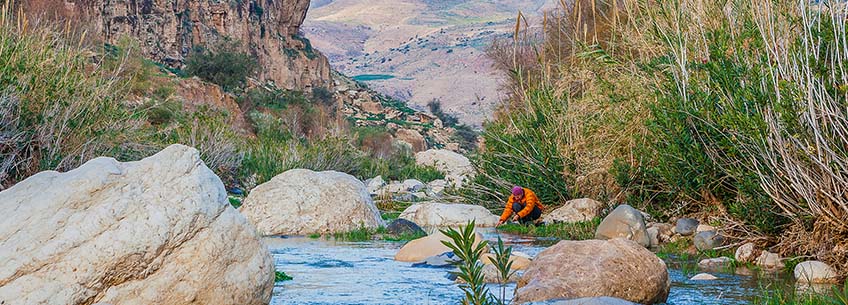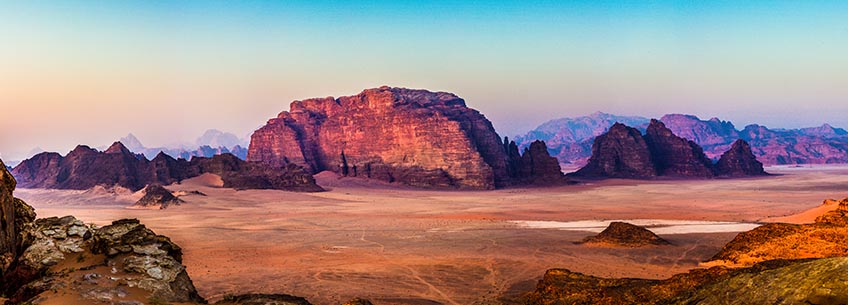PACKING
Packing for Jordan generally follows the same guidelines as packing for a trek anywhere else – ensure you have the equipment needed to keep you safe and comfortable in the wilderness, know how to use it, and don’t carry more weight than needed.
The climate in Jordan is relatively mild during the hiking seasons; snow and freezing temperatures can occur in winter at high elevations, though, and rain and high winds are also very likely in winter. Therefore, your clothing should prepare you for rain and cold, though snow preparations (such as 4-season tents) are not likely to be needed. On the other end of the weather spectrum, you’ll probably encounter heat in all but the coldest months and should bring light, breathable clothing which also provides sun protection. In general, quick-drying, breathable materials like synthetic fabrics and merino wool are better than cotton, with the added benefit of not smelling as bad.

Another important clothing consideration is modesty. It’s best to wear clothes that cover you at least from shoulders to knees out of respect for local customs; you’ll rarely see a Jordanian wearing less clothing than that, and one way to make a good impression on people you meet is to dress in a way that respects the local culture.
If you’re buying outdoor equipment for the first time, keep in mind that two of the most important areas in which it is worthwhile to shop carefully and to invest more money if necessary are your backpack (particularly if buying a large pack for multi-day hiking) and your footwear. Both should be tried on and fitted to you in a store – preferably one staffed by knowledgeable outdoor professionals – as fit is both very personal and very important in terms of comfort and function. Also, remember that less is more – bringing fewer or lighter items means you’ll be carrying less weight, making the hike more enjoyable and less tiring.
Footwear will serve you best when broken in and when your feet are used to what you’re wearing. The best way to avoid blisters and other trip-disrupting foot problems is to wear your boots or shoes for some time before starting a long hike; this allows you to become accustomed to them and to address any issues before heading onto the trail.

Out of respect for the environment and Leave No Trace principles, using a camping stove is preferable to building campfires. Taking wood for campfires deprives the ecosystems of valuable organic matter (which can have a very great impact in Jordan’s arid environments), scars the landscape with fire rings, and runs the risk of spreading a wildfire. Unfortunately, gas for canister stoves is not easy to find outside of Amman, so we recommend a multi-fuel stove such as the MSR Whisperlite International. These stoves can run on gasoline/petrol from any gas station, which is universally available and much cheaper than gas canisters.
When going hiking in wilderness areas where you’re navigating for yourself and help may not be readily at hand, consider the “Ten Essentials” and how they apply to the situations you’ll be in.
At the right, you will find a sample packing list arranged by the Ten Essentials categories. At the end of the list, additional categories have been added for those planning a multi-day backpacking trip.
You can also download a PDF of the full packing list.
- Compass
- GPS device and extra batteries
- Guidebook or topographical maps (if available, though these maps are not readily available in Jordan)
- Hat or “Hatta” (the scarf worn in many configurations by locals)
- Sunscreen
- Sunglasses
- Extra shirt or jacket
- Rain layer (if hiking in the winter)
- Insulated jacket (if hiking in the winter)
- Bandages and plasters
- Moleskin or other blister treatment
- Antiseptic wipes to clean wounds
- Pain reliever/fever reducer, such as acetaminophen/paracetamol or ibuprofen
- Antihistamine, such as Benadryl (diphenhydramine)
- EpiPen or other epinephrine auto-injector in case of bee-sting allergy
- Tweezers
- Sanitary gloves
- Headlamp and extra batteries
Lighter, waterproof matches, and/or other fire-starters
- Pocket knife or multitool
- Strips of duct tape
- Needles and strong thread
- Repair kits for any items in your pack (e.g. inflatable mats, stoves)
- Minimum 3-5 liters is recommended for a day hike; it’s always better to have more than less
- Water purification (filter, Steripen, tablets) to treat natural water sources
- Light tarp and ropes to pitch it
Snacks high in energy and protein, including nuts and fruit, granola bars, or energy bars
- Lightweight backpacking tent
- Sleeping bag or quilt
- Sleeping pad (important for insulation as well as comfort)
- Changes of clothes, especially socks
- Clothing for all weather conditions: hot, cold, sunny, rainy, snowy and windy
- Flip-flops or other evening/camp footwear
- Travel towel
- Soap and/or hand sanitizer
- Personal toiletries
- Toilet paper and a trowel to dig catholes
- Extra plastic bags to pack out garbage
- Multi-fuel camp stove
- Cookware (pots, cups, and utensils)
- Insect repellent
- Chargers and extra batteries for electronics
- Trekking poles







